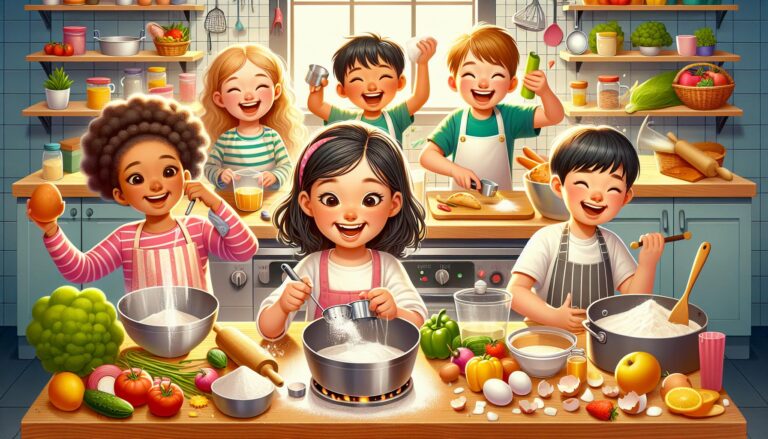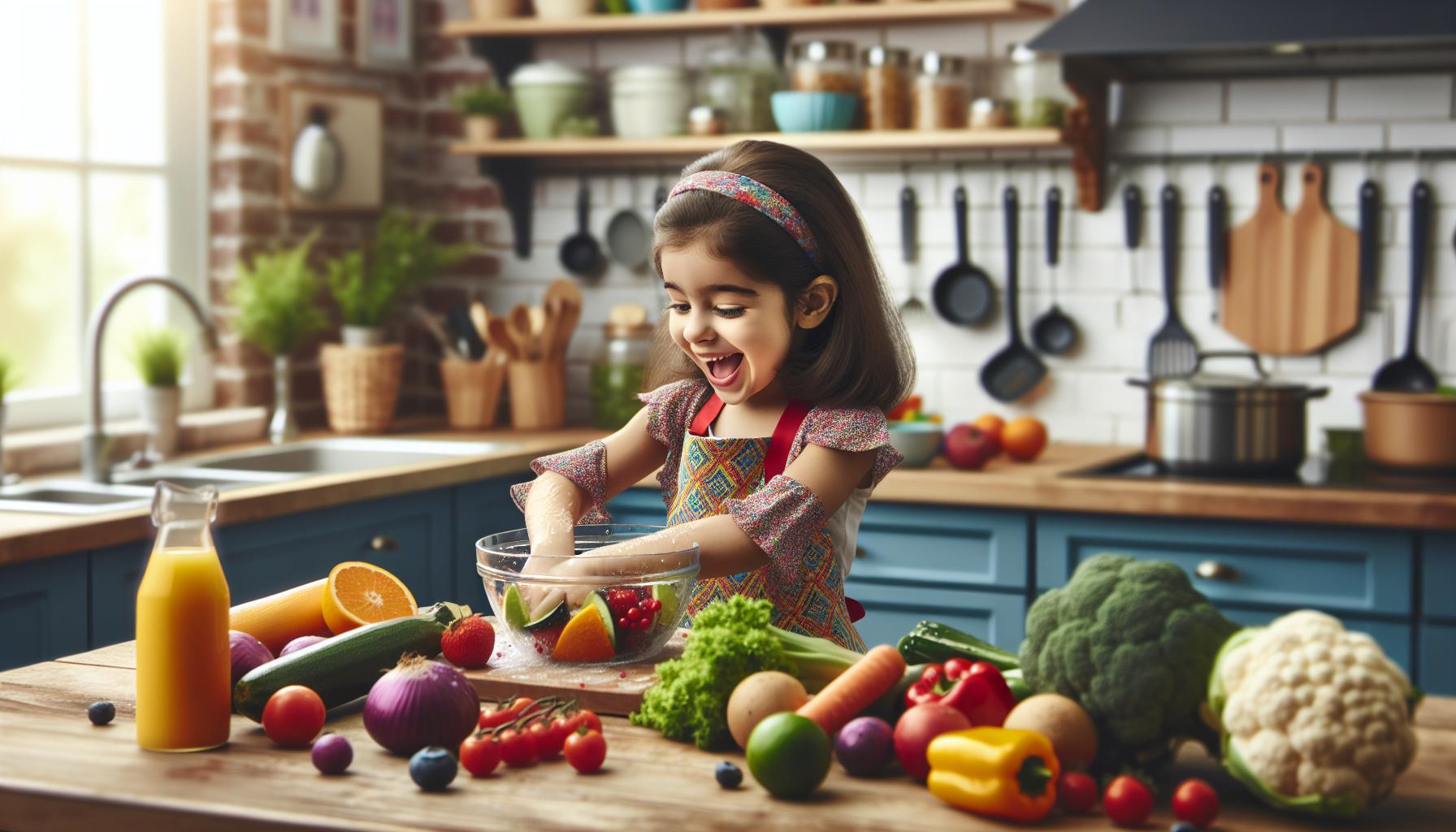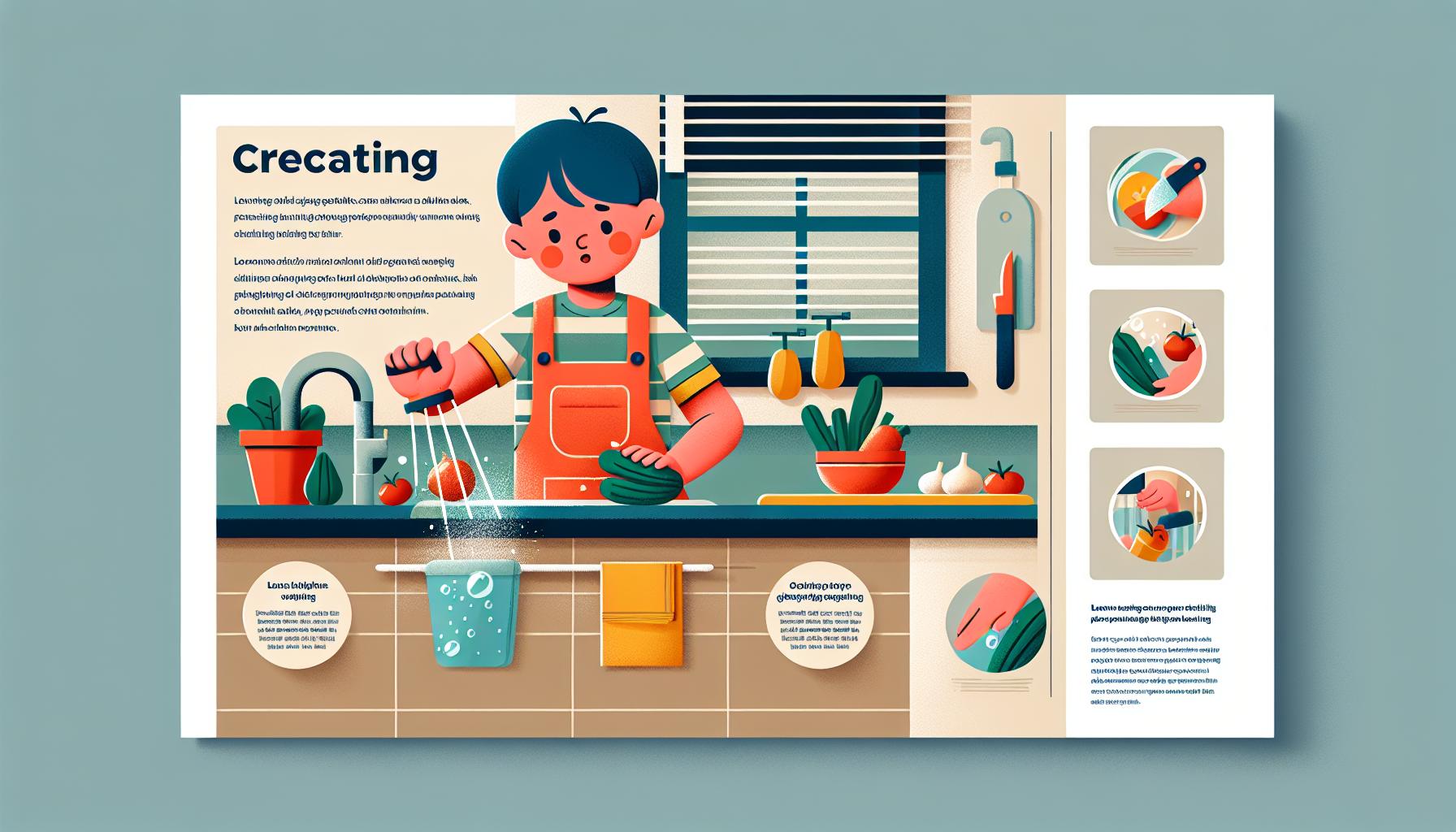
Teaching kids to cook opens up a world of creativity, independence and lifelong skills. We’ve seen firsthand how children light up when they create their own meals and snacks in the kitchen. It’s an adventure that goes beyond just following recipes – it’s about building confidence, understanding nutrition and having fun.
We believe every child can benefit from learning basic cooking skills early in life. Have you noticed how excited kids get when they help prepare family meals? Not only does cooking teach them valuable life skills but it also improves their math abilities through measuring ingredients and enhances their understanding of different cultures through food. Whether your child dreams of becoming a chef or simply wants to make their own breakfast, starting them young in the kitchen will set them up for success.
Key Takeaways
- Teaching kids to cook develops essential life skills including math, reading comprehension, and time management
- Age-appropriate cooking activities range from simple tasks for toddlers (like washing vegetables) to complex meal preparation for teens
- Kitchen safety fundamentals, including proper hand washing, food handling, and tool usage, are crucial for young cooks
- Starting with no-bake recipes and simple stovetop dishes helps build confidence before advancing to more complex cooking
- Children who participate in cooking show increased consumption of fruits and vegetables while reducing processed food choices
Benefits of Teaching Kids to Cook
Teaching kids to cook creates lasting life skills that extend far beyond the kitchen. Here’s how cooking education impacts children’s development and health habits.
Life Skills Development
Cooking helps children master essential life skills through hands-on learning. Kids develop math abilities by measuring ingredients, reading comprehension through following recipes, and time management by coordinating multiple cooking tasks. In the kitchen, children practice:
- Following structured instructions step by step
- Converting measurements and scaling recipes
- Making decisions about ingredient substitutions
- Planning and organizing cooking supplies
- Working safely with kitchen tools
- Cleaning up their workspace
Healthy Eating Habits
Children who cook develop stronger connections to the food they eat. They learn to:
- Identify fresh ingredients and their nutritional value
- Create balanced meals using whole foods
- Understand portion sizes and serving amounts
- Choose healthier snack alternatives
- Appreciate homemade meals over processed foods
- Try new vegetables and fruits through hands-on preparation
A child’s involvement in meal preparation leads to:
| Behavioral Change | Impact Percentage |
|---|---|
| Increased fruit consumption | 75% |
| Greater vegetable intake | 65% |
| Reduced processed food choices | 50% |
| More family meals together | 40% |
Source: Journal of Nutrition Education and Behavior, 2021
This hands-on approach to food education creates positive associations with healthy ingredients, encouraging lifelong nutritious eating habits.
Age-Appropriate Cooking Activities

Cooking activities vary based on a child’s developmental stage. Each age group offers distinct opportunities for learning kitchen skills while maintaining safety.
Toddlers and Preschoolers (Ages 2-5)
Young children excel at simple tasks that build motor skills. Safe activities include:
- Washing fruits and vegetables in cold water
- Tearing lettuce leaves for salads
- Mixing dry ingredients with a wooden spoon
- Sprinkling cheese or herbs on dishes
- Rolling cookie dough into balls
- Mashing soft fruits or cooked vegetables
- Using cookie cutters for soft dough
Adult supervision remains essential, with focus on:
- Using child-safe plastic knives for soft foods
- Practicing hand washing before and after food handling
- Learning kitchen safety rules through songs or games
- Identifying basic ingredients by color and shape
Elementary Age Kids (Ages 6-11)
School-age children develop more complex cooking abilities:
- Measuring ingredients with cups and spoons
- Cracking eggs into a separate bowl
- Using a peeler for vegetables
- Reading simple recipes independently
- Operating a hand mixer
- Making sandwiches and simple snacks
- Learning knife skills with butter knives
Safety guidelines include:
- Proper hand positioning while cutting
- Safe stovetop practices with supervision
- Understanding kitchen tool functions
- Following basic food safety rules
Tweens and Teens (Ages 12+)
Older children master advanced cooking techniques:
- Planning and preparing complete meals
- Using sharp knives with proper technique
- Operating kitchen appliances safely
- Following complex recipes
- Creating original recipe variations
- Mastering food presentation skills
- Understanding nutrition labels
Independence-building activities include:
- Grocery shopping with a budget
- Meal planning for the family
- Learning food preservation methods
- Creating weekly meal schedules
- Understanding cooking terminology
- Practicing advanced baking techniques
Each age group’s activities incorporate continuous supervision that decreases as skills improve.
Essential Kitchen Safety Rules

Teaching kids kitchen safety creates confident young cooks who understand how to prevent accidents in the kitchen. Safe cooking habits start with clear rules that protect children while they explore culinary skills.
Basic Food Handling
- Wash hands with soap and warm water for 20 seconds before touching food
- Clean all fruits and vegetables under running water
- Use separate cutting boards for raw meat and produce
- Store raw meat on the bottom shelf of the refrigerator
- Check food temperature with a thermometer
- Ground beef: 160°F (71°C)
- Chicken: 165°F (74°C)
- Fish: 145°F (63°C)
- Keep pot handles turned inward on the stove
- Use oven mitts for hot pans and dishes
- Walk slowly with kitchen tools
- Keep electrical appliances away from water
- Store sharp objects in designated drawers
- Follow these tool guidelines by age:
- Ages 2-5: Plastic knives only
- Ages 6-11: Butter knives and kid-safe peelers
- Ages 12+: Regular knives with supervision
| Kitchen Tool | Age to Introduce | Required Supervision |
|---|---|---|
| Plastic knife | 3+ years | Direct |
| Butter knife | 6+ years | Direct |
| Regular knife | 12+ years | Close |
| Peeler | 8+ years | Direct |
| Hand mixer | 10+ years | Direct |
| Stovetop | 12+ years | Direct |
| Oven | 13+ years | Close |
- Band-aids
- Burn cream
- Clean cloths
- Ice pack
Fun Beginner Recipes for Kids
Kids’ cooking adventures begin with simple recipes that build confidence in the kitchen. These starter recipes develop foundational culinary skills while creating delicious results.
No-Bake Recipes
No-bake recipes offer a perfect entry point for young chefs ages 4-12. Here’s what makes these recipes ideal for beginners:
- Mix pre-measured dry ingredients in clear bowls for visual learning
- Roll cookie dough balls using clean hands to strengthen motor skills
- Layer ingredients in parfait glasses to practice food presentation
- Press crumb crusts into pans to understand texture differences
- Combine ingredients in sequence following illustrated instructions
Popular no-bake options include:
- Energy bites with oats, honey & nut butter
- Yogurt parfaits with fresh fruit & granola
- Rice crispy treats with marshmallows
- Chocolate-dipped frozen banana pops
- Trail mix with dried fruits & cereals
Simple Stovetop Dishes
Stovetop cooking introduces kids ages 8-12 to basic heat safety while creating tasty meals:
Key skills learned:
- Setting appropriate burner temperatures
- Using wooden spoons to stir ingredients
- Identifying when foods are fully cooked
- Following recipe timing instructions
- Practicing kitchen safety near heat
Beginner-friendly stovetop recipes:
- Scrambled eggs with cheese
- Pancakes from pre-mixed batter
- Mac & cheese with simple ingredients
- Grilled cheese sandwiches
- Vegetable soup with pre-cut items
- Clear temperature guidelines
- Step-by-step visual instructions
- Pre-measured ingredient portions
- Safety reminders for heat zones
- Easy cleanup suggestions
Building Kitchen Confidence
Teaching kids to cook builds their confidence through measurable achievements and clear instructions. Each successful dish creates a foundation for more advanced cooking skills.
Measuring and Math Skills
Cooking transforms abstract math concepts into practical applications. Kids learn fractions by measuring 1/2 cup of flour or doubling a recipe that serves 4 people to feed 8. Here’s how measuring skills develop through cooking:
- Converting measurements between cups, tablespoons and teaspoons
- Understanding volume by filling measuring cups to exact levels
- Learning weight measurements with kitchen scales
- Practicing multiplication when scaling recipes up or down
- Using division to portion servings equally
Following Instructions
Kids develop sequential thinking by following recipe steps in order. Clear instructions create a framework for success:
- Reading recipes completely before starting
- Gathering ingredients and tools first
- Breaking complex recipes into smaller tasks
- Setting timers for each cooking step
- Checking off completed steps as they go
We introduce step-by-step photo recipes for visual learners. Color-coded measuring tools help kids associate quantities with specific measurements. For example:
- Red cups for dry ingredients
- Blue spoons for liquid ingredients
- Green bowls for mixing
- Yellow timers for monitoring cook times
Each successful recipe builds confidence for tackling more challenging dishes. How does your child respond to following recipe instructions? Which measuring tools work best for their learning style?
Conclusion
Teaching kids to cook is one of the most rewarding investments we can make in their future. The kitchen becomes a classroom where math science and creativity blend seamlessly with life skills and cultural awareness.
We’ve seen how cooking education transforms young minds fostering independence and building confidence through hands-on learning. It’s clear that when we empower children with cooking skills we’re not just teaching them about food – we’re preparing them for life.
Let’s inspire the next generation of home cooks by making the kitchen a safe welcoming space where learning and fun go hand in hand. Together we can help our children develop healthy relationships with food that will serve them well throughout their lives.
Frequently Asked Questions
At what age should children start learning to cook?
Children can start learning cooking skills as early as age 2. Start with simple tasks like washing fruits or mixing ingredients. Gradually introduce more complex tasks as they grow older. The key is to match activities with their developmental stage and always prioritize safety.
What are the benefits of teaching children to cook?
Cooking teaches children essential life skills, improves math abilities through measuring, develops cultural awareness, and promotes healthy eating habits. It also boosts confidence, creativity, and independence while fostering quality family time and better food choices.
How can I ensure kitchen safety when cooking with kids?
Establish clear safety rules, provide age-appropriate tools, and maintain constant supervision. Use plastic knives for young children, teach proper hand washing, and keep a first aid kit nearby. Always demonstrate proper techniques and ensure children understand basic food safety guidelines.
What are good starter recipes for children?
Begin with no-bake recipes like energy bites, yogurt parfaits, and rice crispy treats for younger children (ages 4-12). Progress to simple stovetop recipes like scrambled eggs and grilled cheese for older kids (ages 8-12). Choose recipes with clear, visual instructions.
How does cooking help with academic skills?
Cooking naturally incorporates math through measuring and scaling recipes, enhances reading comprehension through following instructions, and develops scientific thinking through observing cooking processes. It turns abstract concepts into practical, hands-on learning experiences.
What kitchen tools are appropriate for different age groups?
Ages 2-5: Plastic knives, mixing spoons, and measuring cups
Ages 6-11: Butter knives, whisks, and basic measuring tools
Ages 12+: Regular knives (with supervision), more complex kitchen equipment, and cooking appliances
How can I make cooking fun and educational?
Use colorful ingredients, incorporate games, and make learning interactive. Create step-by-step photo recipes, use color-coded measuring tools, and celebrate their achievements. Let children make age-appropriate choices and be creative with ingredients.
What are essential safety rules for kids in the kitchen?
Always wash hands before cooking, keep workspace clean, use separate cutting boards for different foods, handle hot items with adult supervision, and learn proper knife safety. Teach children to read and follow recipe instructions carefully.

